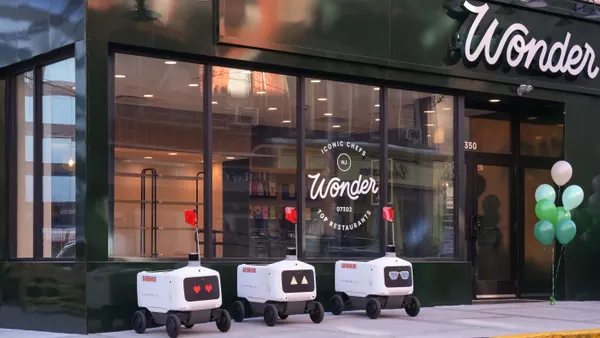Dive Brief:
- Burger King is offering a new service in Mexico City that delivers food to consumers stuck in heavy traffic called the Traffic Jam Whopper, according to The Washington Post. After the successful pilot, the company says it's eyeing Los Angeles, Shanghai and Sao Paulo for its next expansion.
- The service relies on real-time traffic data to identify the areas with the most congestion, banner ads on Waze and digital billboards to let commuters know that the service is available from a Burger King location within 1.8 miles. The ads also show drivers how much time they have to order before the traffic clears.
- Drivers can use voice command to place their order and the billboard shows them when the order will be delivered with updates on its progress. Burger King also uses real-time geolocation to help the delivery driver find the slowly moving consumer.
Dive Insight:
As restaurants push to find the latest innovative delivery options, the success of the Traffic Jam Whopper pilot shows that Burger King could have a new tool in its arsenal. The Mexico City pilot resulted in a 63% increase in daily orders and downloads of its app increased by 44% within one week, according to AdAge.
This is not the first time Burger King has used geolocation. In December, Burger King trolled its rival McDonald's by offering penny Whoppers to users of its revamped BK App who were within 600 feet of a McDonald's. Its "Whopper Detour," however, was a week-long stunt whereas the burger chain may have found a permanent way to tap into the technology with its roadside delivery service.
How to use new technology effectively is no easy feat. Other QSRs have used geolocation to serve up mobile ads while its customers are in transit, with some success. McDonald's reported in March that it saw 6.4 million mobile impressions and drove 8,400 in-app actions by using geofenced billboards on Waze. Dunkin' tested a geofencing campaign in 2014 that gave coupons to people who were near its competitors. According to Mobile Marketer, the redemption rate was 3.6%.
Domino's, which is no stranger to experimentation, created its Hotspots service last year that let customers order from almost anywhere, including sporting venues, beaches and the park. Much like Burger King's Traffic Jam Whopper, a delivery driver or cyclist drops off a pizza curbside. A major difference, however, is that Burger King works only in congestion, but is delivering to a moving target. On the other hand, Domino's had an agreed upon hand-off location via Hotspots.










